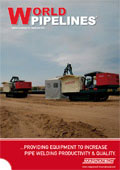Editorial comment
Rumour has it that the two competing camps vying to build an Alaska natural gas pipeline have been involved in preliminary talks to merge projects. Surprised? Well, a possible joining of forces between the Denali project and the TransCanada/ExxonMobil project has always been a quiet third option in the winding tale of the Alaska gas pipeline and anyway, we didn’t expect both lines to be built simultaneously did we?
Register for free »
Get started now for absolutely FREE, no credit card required.
Whether the reports are true or not, spokesmen for Denali, the BP/ConocoPhillips project that envisages a pipeline from Alaska’s North Slope into Canada, have in the past appeared open to a potential merger. Dave MacDowell, one such spokesman, said he wasn't aware of discussions between the two competing bidders, but added that the Denali partners, "have said repeatedly they are open to considering involvement of any entity that adds value and takes on risk."
The rumours come at an interesting time for Alaskan politics, as the race to be the next Governor is in full swing.
Gov. Sean Parnell became the 12th Governor of Alaska in July 2009 when Sarah Palin resigned. Parnell has officially announced that he will be running for a first full-term in 2010 and currently leads in the polls.
Oil and gas issues will undoubtedly play a big part in voters’ decisions in the November gubernatorial elections – as each candidate puts forward his or her vision for the manner in which oil and gas revenues and activity should shape the state. A major gas pipeline would create jobs and go some way to make up for inevitable declining oil revenues.
Gov. Parnell is committed to the Alaska Gasline Inducement Act, the state’s venture to spur competition for the line. AGIA officially backs the TransCanada/ExxonMobil venture and, as such, the state has committed up to US$ 500 million in subsidies for the project. This proposal has two options: a pipeline from the North Slope into Canada, or, a pipeline from the north Slope to a plant in Valdez, where gas could be liquefied and shipped out, possibly overseas.
The current glut of shale gas in the US means that this shipping option is a wise move – the long delay in getting an Alaska pipeline anywhere near the ground has coincided with a sudden boom in domestic gas production in the lower 48 states, which questions the very need for an Alaska gasline to begin with.
Whoever becomes Governor will need to carefully balance the demands of the energy majors and the shippers, with the needs of the state, against the fits and starts of the global energy market.
Revenue from oil and natural gas has always been crucial to Alaska’s economy. In 1867, and for a bargain price of US$ 7.2 million, Russia handed over Alaska to the USA. The area has since generated more than US$ 141 billion worth of oil. How the state moves forward, how it best makes use of its energy revenues, and which pipeline, if any, gets built, is the challenge ahead for the new Governor.


